PA1-16927
antibody from Invitrogen Antibodies
Targeting: ERN1
IRE1, IRE1P
 Western blot
Western blot ELISA
ELISA Immunoprecipitation
Immunoprecipitation Immunohistochemistry
Immunohistochemistry Chromatin Immunoprecipitation
Chromatin Immunoprecipitation Other assay
Other assayAntibody data
- Antibody Data
- Antigen structure
- References [61]
- Comments [0]
- Validations
- Western blot [3]
- Immunohistochemistry [1]
- Other assay [28]
Submit
Validation data
Reference
Comment
Report error
- Product number
- PA1-16927 - Provider product page

- Provider
- Invitrogen Antibodies
- Product name
- Phospho-IRE1 alpha (Ser724) Polyclonal Antibody
- Antibody type
- Polyclonal
- Antigen
- Synthetic peptide
- Description
- Recommended positive controls: Human pancreas whole tissue Lysate (adult whole tumor), Human epididymis whole tissue lysate (adult whole normal)
- Reactivity
- Human, Mouse, Rat, Drosophila, Goat, Hamster, Porcine, Rabbit
- Host
- Rabbit
- Isotype
- IgG
- Vial size
- 100 μL
- Concentration
- 1 mg/mL
- Storage
- -20°C, Avoid Freeze/Thaw Cycles
Submitted references Differential ER stress as a driver of cell fate following ricin toxin exposure.
Endoplasmic Reticulum Stress Is Involved in Glucocorticoid-Induced Apoptosis in PC12 Cells.
Dietary saturated fatty acid palmitate promotes cartilage lesions and activates the unfolded protein response pathway in mouse knee joints.
Aging and Hypercholesterolemia Differentially Affect the Unfolded Protein Response in the Vasculature of ApoE(-/-) Mice.
Elucidation of the Molecular Pathways Involved in the Protective Effects of AUY-922 in LPS-Induced Inflammation in Mouse Lungs.
Involvement of the unfolded protein response in the protective effects of growth hormone releasing hormone antagonists in the lungs.
Restoring the endothelial barrier function in the elderly.
The P300/XBP1s/Herpud1 axis promotes macrophage M2 polarization and the development of choroidal neovascularization.
Neuronal VCP loss of function recapitulates FTLD-TDP pathology.
SARS-CoV-2 ORF3a Induces Incomplete Autophagy via the Unfolded Protein Response.
Swimming Differentially Affects T2DM-Induced Skeletal Muscle ER Stress and Mitochondrial Dysfunction Related to MAM.
Endoplasmic Reticulum Stress Activation in Alport Syndrome Varies Between Genotype and Cell Type.
Age-Related Decline in Expression of Molecular Chaperones Induces Endoplasmic Reticulum Stress and Chondrocyte Apoptosis in Articular Cartilage.
Inhibition of USP14 induces ER stress-mediated autophagy without apoptosis in lung cancer cell line A549.
Antifungal itraconazole ameliorates experimental autoimmune encephalomyelitis through a novel mechanism of action.
Calbindin-D(9k) is a Novel Risk Gene for Neurodegenerative Disease.
IRE1α Promotes Zika Virus Infection via XBP1.
Proteome Instability Is a Therapeutic Vulnerability in Mismatch Repair-Deficient Cancer.
Increased proliferation of hepatic periportal ductal progenitor cells contributes to persistent hypermetabolism after trauma.
Towards Age-Related Anti-Inflammatory Therapy: Klotho Suppresses Activation of ER and Golgi Stress Response in Senescent Monocytes.
Homeostatic regulation of STING protein at the resting state by stabilizer TOLLIP.
PERK-mediated expression of peptidylglycine α-amidating monooxygenase supports angiogenesis in glioblastoma.
Inositol-requiring enzyme 1α links palmitate-induced mTOR activation and lipotoxicity in hepatocytes.
Synaptic Loss, ER Stress and Neuro-Inflammation Emerge Late in the Lateral Temporal Cortex and Associate with Progressive Tau Pathology in Alzheimer's Disease.
The activation of retinal HCA2 receptors by systemic beta-hydroxybutyrate inhibits diabetic retinal damage through reduction of endoplasmic reticulum stress and the NLRP3 inflammasome.
Dissecting the Anticancer Mechanism of Trifluoperazine on Pancreatic Ductal Adenocarcinoma.
Adaptive endoplasmic reticulum stress signalling via IRE1α-XBP1 preserves self-renewal of haematopoietic and pre-leukaemic stem cells.
Fat storage-inducing transmembrane protein 2 (FIT2) is less abundant in type 2 diabetes, and regulates triglyceride accumulation and insulin sensitivity in adipocytes.
IRE1α-XBP1s pathway promotes prostate cancer by activating c-MYC signaling.
Tumor necrosis factor-α triggers opposing signals in head and neck squamous cell carcinoma and induces apoptosis via mitochondrial- and non-mitochondrial-dependent pathways.
TRPML1 Promotes Protein Homeostasis in Melanoma Cells by Negatively Regulating MAPK and mTORC1 Signaling.
The Human Cytomegalovirus Endoplasmic Reticulum-Resident Glycoprotein UL148 Activates the Unfolded Protein Response.
RNA Splicing in the Transition from B Cells to Antibody-Secreting Cells: The Influences of ELL2, Small Nuclear RNA, and Endoplasmic Reticulum Stress.
Podocytes exhibit a specialized protein quality control employing derlin-2 in kidney disease.
Comparative proteomic profiling reveals a role for Cisd2 in skeletal muscle aging.
Featured Article: Deterioration of visual function mediated by senescence-associated endoplasmic reticulum stress in inflammatory tie2-TNF mice.
Novel β-phenylacrylic acid derivatives exert anti-cancer activity by inducing Src-mediated apoptosis in wild-type KRAS colon cancer.
PDI regulates seizure activity via NMDA receptor redox in rats.
HCV induces transforming growth factor β1 through activation of endoplasmic reticulum stress and the unfolded protein response.
Imiquimod-induced apoptosis of melanoma cells is mediated by ER stress-dependent Noxa induction and enhanced by NF-κB inhibition.
Anti-inflammatory actions of (-)-epicatechin in the adipose tissue of obese mice.
LRP1 Protein Deficiency Exacerbates Palmitate-induced Steatosis and Toxicity in Hepatocytes.
TMEM33: a new stress-inducible endoplasmic reticulum transmembrane protein and modulator of the unfolded protein response signaling.
Attenuation of oxygen fluctuation-induced endoplasmic reticulum stress in human lens epithelial cells.
Divergent androgen regulation of unfolded protein response pathways drives prostate cancer.
CD133⁺ melanoma subpopulation acquired resistance to caffeic acid phenethyl ester-induced apoptosis is attributed to the elevated expression of ABCB5: significance for melanoma treatment.
Methionine restriction restores a younger metabolic phenotype in adult mice with alterations in fibroblast growth factor 21.
Attenuation of unfolded protein response and apoptosis by mReg2 induced GRP78 in mouse insulinoma cells.
Inhibition of JNK by novel curcumin analog C66 prevents diabetic cardiomyopathy with a preservation of cardiac metallothionein expression.
Dipeptidyl petidase-IV inhibitor (gemigliptin) inhibits tunicamycin-induced endoplasmic reticulum stress, apoptosis and inflammation in H9c2 cardiomyocytes.
CYP2J2-derived epoxyeicosatrienoic acids suppress endoplasmic reticulum stress in heart failure.
Unfolded protein response signaling by transcription factor XBP-1 regulates ADAM10 and is affected in Alzheimer's disease.
Deficiency of liver Comparative Gene Identification-58 causes steatohepatitis and fibrosis in mice.
Vinblastine-induced apoptosis of melanoma cells is mediated by Ras homologous A protein (Rho A) via mitochondrial and non-mitochondrial-dependent mechanisms.
ER stress negatively modulates the expression of the miR-199a/214 cluster to regulates tumor survival and progression in human hepatocellular cancer.
PARP16 is a tail-anchored endoplasmic reticulum protein required for the PERK- and IRE1α-mediated unfolded protein response.
Monitoring endoplasmic reticulum stress responsive mRNAs by RNA sequencing.
HDLs inhibit endoplasmic reticulum stress and autophagic response induced by oxidized LDLs.
Constitutive role for IRE1α-XBP1 signaling pathway in the insulin-mediated hepatic lipogenic program.
Apoptosis-related protein-2 triggers melanoma cell death by a mechanism including both endoplasmic reticulum stress and mitochondrial dysregulation.
Down-regulation of BiP/GRP78 sensitizes resistant prostate cancer cells to gene-therapeutic overexpression of REIC/Dkk-3.
Peterson-Reynolds C, Mantis NJ
FASEB bioAdvances 2022 Jan;4(1):60-75
FASEB bioAdvances 2022 Jan;4(1):60-75
Endoplasmic Reticulum Stress Is Involved in Glucocorticoid-Induced Apoptosis in PC12 Cells.
Yi S, Shi W, Zuo M, Wang S, Ma R, Bi H, Cong B, Li Y
Analytical cellular pathology (Amsterdam) 2021;2021:5565671
Analytical cellular pathology (Amsterdam) 2021;2021:5565671
Dietary saturated fatty acid palmitate promotes cartilage lesions and activates the unfolded protein response pathway in mouse knee joints.
Tan L, Harper LR, Armstrong A, Carlson CS, Yammani RR
PloS one 2021;16(2):e0247237
PloS one 2021;16(2):e0247237
Aging and Hypercholesterolemia Differentially Affect the Unfolded Protein Response in the Vasculature of ApoE(-/-) Mice.
Zhou Y, Wan X, Seidel K, Zhang M, Goodman JB, Seta F, Hamburg N, Han J
Journal of the American Heart Association 2021 Sep 21;10(18):e020441
Journal of the American Heart Association 2021 Sep 21;10(18):e020441
Elucidation of the Molecular Pathways Involved in the Protective Effects of AUY-922 in LPS-Induced Inflammation in Mouse Lungs.
Akhter MS, Uddin MA, Kubra KT, Barabutis N
Pharmaceuticals (Basel, Switzerland) 2021 May 29;14(6)
Pharmaceuticals (Basel, Switzerland) 2021 May 29;14(6)
Involvement of the unfolded protein response in the protective effects of growth hormone releasing hormone antagonists in the lungs.
Akhter MS, Uddin MA, Schally AV, Kubra KT, Barabutis N
Journal of cell communication and signaling 2021 Mar;15(1):125-129
Journal of cell communication and signaling 2021 Mar;15(1):125-129
Restoring the endothelial barrier function in the elderly.
Barabutis N, Akhter MS, Kubra KT, Uddin MA
Mechanisms of ageing and development 2021 Jun;196:111479
Mechanisms of ageing and development 2021 Jun;196:111479
The P300/XBP1s/Herpud1 axis promotes macrophage M2 polarization and the development of choroidal neovascularization.
Li W, Wang Y, Zhu L, Du S, Mao J, Wang Y, Wang S, Bo Q, Tu Y, Yi Q
Journal of cellular and molecular medicine 2021 Jul;25(14):6709-6720
Journal of cellular and molecular medicine 2021 Jul;25(14):6709-6720
Neuronal VCP loss of function recapitulates FTLD-TDP pathology.
Wani A, Zhu J, Ulrich JD, Eteleeb A, Sauerbeck AD, Reitz SJ, Arhzaouy K, Ikenaga C, Yuede CM, Pittman SK, Wang F, Li S, Benitez BA, Cruchaga C, Kummer TT, Harari O, Chou TF, Schröder R, Clemen CS, Weihl CC
Cell reports 2021 Jul 20;36(3):109399
Cell reports 2021 Jul 20;36(3):109399
SARS-CoV-2 ORF3a Induces Incomplete Autophagy via the Unfolded Protein Response.
Su WQ, Yu XJ, Zhou CM
Viruses 2021 Dec 9;13(12)
Viruses 2021 Dec 9;13(12)
Swimming Differentially Affects T2DM-Induced Skeletal Muscle ER Stress and Mitochondrial Dysfunction Related to MAM.
Zhang Z, Cui D, Zhang T, Sun Y, Ding S
Diabetes, metabolic syndrome and obesity : targets and therapy 2020;13:1417-1428
Diabetes, metabolic syndrome and obesity : targets and therapy 2020;13:1417-1428
Endoplasmic Reticulum Stress Activation in Alport Syndrome Varies Between Genotype and Cell Type.
Wang C, Liang S, Xing S, Xu K, Xiao H, Deng H, Wang X, Chen L, Ding J, Wang F
Frontiers in genetics 2020;11:36
Frontiers in genetics 2020;11:36
Age-Related Decline in Expression of Molecular Chaperones Induces Endoplasmic Reticulum Stress and Chondrocyte Apoptosis in Articular Cartilage.
Tan L, Register TC, Yammani RR
Aging and disease 2020 Oct;11(5):1091-1102
Aging and disease 2020 Oct;11(5):1091-1102
Inhibition of USP14 induces ER stress-mediated autophagy without apoptosis in lung cancer cell line A549.
Moghadami AA, Aboutalebi Vand Beilankouhi E, Kalantary-Charvadeh A, Hamzavi M, Mosayyebi B, Sedghi H, Ghorbani Haghjo A, Nazari Soltan Ahmad S
Cell stress & chaperones 2020 Nov;25(6):909-917
Cell stress & chaperones 2020 Nov;25(6):909-917
Antifungal itraconazole ameliorates experimental autoimmune encephalomyelitis through a novel mechanism of action.
Huang H, Tian X, Peng X, Huang L, Mei L, Zhan Y, Chen S, Wu H, Wei G, Cai X
Advances in clinical and experimental medicine : official organ Wroclaw Medical University 2020 May;29(5):535-545
Advances in clinical and experimental medicine : official organ Wroclaw Medical University 2020 May;29(5):535-545
Calbindin-D(9k) is a Novel Risk Gene for Neurodegenerative Disease.
Jung EM, Yoo YM, Park SY, Ahn C, Jeon BH, Hong EJ, Kim WY, Jeung EB
Cellular physiology and biochemistry : international journal of experimental cellular physiology, biochemistry, and pharmacology 2020 May 2;54(3):438-456
Cellular physiology and biochemistry : international journal of experimental cellular physiology, biochemistry, and pharmacology 2020 May 2;54(3):438-456
IRE1α Promotes Zika Virus Infection via XBP1.
Kolpikova EP, Tronco AR, Hartigh ABD, Jackson KJ, Iwawaki T, Fink SL
Viruses 2020 Mar 3;12(3)
Viruses 2020 Mar 3;12(3)
Proteome Instability Is a Therapeutic Vulnerability in Mismatch Repair-Deficient Cancer.
McGrail DJ, Garnett J, Yin J, Dai H, Shih DJH, Lam TNA, Li Y, Sun C, Li Y, Schmandt R, Wu JY, Hu L, Liang Y, Peng G, Jonasch E, Menter D, Yates MS, Kopetz S, Lu KH, Broaddus R, Mills GB, Sahni N, Lin SY
Cancer cell 2020 Mar 16;37(3):371-386.e12
Cancer cell 2020 Mar 16;37(3):371-386.e12
Increased proliferation of hepatic periportal ductal progenitor cells contributes to persistent hypermetabolism after trauma.
Diao L, Yousuf Y, Amini-Nik S, Jeschke MG
Journal of cellular and molecular medicine 2020 Jan;24(2):1578-1587
Journal of cellular and molecular medicine 2020 Jan;24(2):1578-1587
Towards Age-Related Anti-Inflammatory Therapy: Klotho Suppresses Activation of ER and Golgi Stress Response in Senescent Monocytes.
Mytych J, Sołek P, Będzińska A, Rusinek K, Warzybok A, Tabęcka-Łonczyńska A, Koziorowski M
Cells 2020 Jan 21;9(2)
Cells 2020 Jan 21;9(2)
Homeostatic regulation of STING protein at the resting state by stabilizer TOLLIP.
Pokatayev V, Yang K, Tu X, Dobbs N, Wu J, Kalb RG, Yan N
Nature immunology 2020 Feb;21(2):158-167
Nature immunology 2020 Feb;21(2):158-167
PERK-mediated expression of peptidylglycine α-amidating monooxygenase supports angiogenesis in glioblastoma.
Soni H, Bode J, Nguyen CDL, Puccio L, Neßling M, Piro RM, Bub J, Phillips E, Ahrends R, Eipper BA, Tews B, Goidts V
Oncogenesis 2020 Feb 13;9(2):18
Oncogenesis 2020 Feb 13;9(2):18
Inositol-requiring enzyme 1α links palmitate-induced mTOR activation and lipotoxicity in hepatocytes.
Chen Y, Griffiths A, Wang J, Zhang T, Song Q, Song Z
American journal of physiology. Cell physiology 2020 Dec 1;319(6):C1130-C1140
American journal of physiology. Cell physiology 2020 Dec 1;319(6):C1130-C1140
Synaptic Loss, ER Stress and Neuro-Inflammation Emerge Late in the Lateral Temporal Cortex and Associate with Progressive Tau Pathology in Alzheimer's Disease.
Buchanan H, Mackay M, Palmer K, Tothová K, Katsur M, Platt B, Koss DJ
Molecular neurobiology 2020 Aug;57(8):3258-3272
Molecular neurobiology 2020 Aug;57(8):3258-3272
The activation of retinal HCA2 receptors by systemic beta-hydroxybutyrate inhibits diabetic retinal damage through reduction of endoplasmic reticulum stress and the NLRP3 inflammasome.
Trotta MC, Maisto R, Guida F, Boccella S, Luongo L, Balta C, D'Amico G, Herman H, Hermenean A, Bucolo C, D'Amico M
PloS one 2019;14(1):e0211005
PloS one 2019;14(1):e0211005
Dissecting the Anticancer Mechanism of Trifluoperazine on Pancreatic Ductal Adenocarcinoma.
Huang C, Lan W, Fraunhoffer N, Meilerman A, Iovanna J, Santofimia-Castaño P
Cancers 2019 Nov 26;11(12)
Cancers 2019 Nov 26;11(12)
Adaptive endoplasmic reticulum stress signalling via IRE1α-XBP1 preserves self-renewal of haematopoietic and pre-leukaemic stem cells.
Liu L, Zhao M, Jin X, Ney G, Yang KB, Peng F, Cao J, Iwawaki T, Del Valle J, Chen X, Li Q
Nature cell biology 2019 Mar;21(3):328-337
Nature cell biology 2019 Mar;21(3):328-337
Fat storage-inducing transmembrane protein 2 (FIT2) is less abundant in type 2 diabetes, and regulates triglyceride accumulation and insulin sensitivity in adipocytes.
Agrawal M, Yeo CR, Shabbir A, Chhay V, Silver DL, Magkos F, Vidal-Puig A, Toh SA
FASEB journal : official publication of the Federation of American Societies for Experimental Biology 2019 Jan;33(1):430-440
FASEB journal : official publication of the Federation of American Societies for Experimental Biology 2019 Jan;33(1):430-440
IRE1α-XBP1s pathway promotes prostate cancer by activating c-MYC signaling.
Sheng X, Nenseth HZ, Qu S, Kuzu OF, Frahnow T, Simon L, Greene S, Zeng Q, Fazli L, Rennie PS, Mills IG, Danielsen H, Theis F, Patterson JB, Jin Y, Saatcioglu F
Nature communications 2019 Jan 24;10(1):323
Nature communications 2019 Jan 24;10(1):323
Tumor necrosis factor-α triggers opposing signals in head and neck squamous cell carcinoma and induces apoptosis via mitochondrial- and non-mitochondrial-dependent pathways.
Selimovic D, Wahl RU, Ruiz E, Aslam R, Flanagan TW, Hassan SY, Santourlidis S, Haikel Y, Friedlander P, Megahed M, Kandil E, Hassan M
International journal of oncology 2019 Dec;55(6):1324-1338
International journal of oncology 2019 Dec;55(6):1324-1338
TRPML1 Promotes Protein Homeostasis in Melanoma Cells by Negatively Regulating MAPK and mTORC1 Signaling.
Kasitinon SY, Eskiocak U, Martin M, Bezwada D, Khivansara V, Tasdogan A, Zhao Z, Mathews T, Aurora AB, Morrison SJ
Cell reports 2019 Aug 27;28(9):2293-2305.e9
Cell reports 2019 Aug 27;28(9):2293-2305.e9
The Human Cytomegalovirus Endoplasmic Reticulum-Resident Glycoprotein UL148 Activates the Unfolded Protein Response.
Siddiquey MNA, Zhang H, Nguyen CC, Domma AJ, Kamil JP
Journal of virology 2018 Oct 15;92(20)
Journal of virology 2018 Oct 15;92(20)
RNA Splicing in the Transition from B Cells to Antibody-Secreting Cells: The Influences of ELL2, Small Nuclear RNA, and Endoplasmic Reticulum Stress.
Nelson AM, Carew NT, Smith SM, Milcarek C
Journal of immunology (Baltimore, Md. : 1950) 2018 Nov 15;201(10):3073-3083
Journal of immunology (Baltimore, Md. : 1950) 2018 Nov 15;201(10):3073-3083
Podocytes exhibit a specialized protein quality control employing derlin-2 in kidney disease.
Ren G, Tardi NJ, Matsuda F, Koh KH, Ruiz P, Wei C, Altintas MM, Ploegh H, Reiser J
American journal of physiology. Renal physiology 2018 Mar 1;314(3):F471-F482
American journal of physiology. Renal physiology 2018 Mar 1;314(3):F471-F482
Comparative proteomic profiling reveals a role for Cisd2 in skeletal muscle aging.
Huang YL, Shen ZQ, Wu CY, Teng YC, Liao CC, Kao CH, Chen LK, Lin CH, Tsai TF
Aging cell 2018 Feb;17(1)
Aging cell 2018 Feb;17(1)
Featured Article: Deterioration of visual function mediated by senescence-associated endoplasmic reticulum stress in inflammatory tie2-TNF mice.
Lenin R, Nagy PG, Gentry J, Gangaraju R
Experimental biology and medicine (Maywood, N.J.) 2018 Aug;243(12):976-984
Experimental biology and medicine (Maywood, N.J.) 2018 Aug;243(12):976-984
Novel β-phenylacrylic acid derivatives exert anti-cancer activity by inducing Src-mediated apoptosis in wild-type KRAS colon cancer.
Kim SJ, Noh TH, Son S, Kim DH, Kim W, Lee Y, Choo J, Heo G, Kim MJ, Chung HY, Jung Y, Jung JH, Moon HR, Im E
Cell death & disease 2018 Aug 29;9(9):877
Cell death & disease 2018 Aug 29;9(9):877
PDI regulates seizure activity via NMDA receptor redox in rats.
Kim JY, Ko AR, Hyun HW, Min SJ, Kim JE
Scientific reports 2017 Feb 15;7:42491
Scientific reports 2017 Feb 15;7:42491
HCV induces transforming growth factor β1 through activation of endoplasmic reticulum stress and the unfolded protein response.
Chusri P, Kumthip K, Hong J, Zhu C, Duan X, Jilg N, Fusco DN, Brisac C, Schaefer EA, Cai D, Peng LF, Maneekarn N, Lin W, Chung RT
Scientific reports 2016 Mar 1;6:22487
Scientific reports 2016 Mar 1;6:22487
Imiquimod-induced apoptosis of melanoma cells is mediated by ER stress-dependent Noxa induction and enhanced by NF-κB inhibition.
El-Khattouti A, Selimovic D, Hannig M, Taylor EB, Abd Elmageed ZY, Hassan SY, Haikel Y, Kandil E, Leverkus M, Brodell RT, Megahed M, Hassan M
Journal of cellular and molecular medicine 2016 Feb;20(2):266-86
Journal of cellular and molecular medicine 2016 Feb;20(2):266-86
Anti-inflammatory actions of (-)-epicatechin in the adipose tissue of obese mice.
Bettaieb A, Cremonini E, Kang H, Kang J, Haj FG, Oteiza PI
The international journal of biochemistry & cell biology 2016 Dec;81(Pt B):383-392
The international journal of biochemistry & cell biology 2016 Dec;81(Pt B):383-392
LRP1 Protein Deficiency Exacerbates Palmitate-induced Steatosis and Toxicity in Hepatocytes.
Hamlin AN, Basford JE, Jaeschke A, Hui DY
The Journal of biological chemistry 2016 Aug 5;291(32):16610-9
The Journal of biological chemistry 2016 Aug 5;291(32):16610-9
TMEM33: a new stress-inducible endoplasmic reticulum transmembrane protein and modulator of the unfolded protein response signaling.
Sakabe I, Hu R, Jin L, Clarke R, Kasid UN
Breast cancer research and treatment 2015 Sep;153(2):285-97
Breast cancer research and treatment 2015 Sep;153(2):285-97
Attenuation of oxygen fluctuation-induced endoplasmic reticulum stress in human lens epithelial cells.
Zheng XY, Xu J, Chen XI, Li W, Wang TY
Experimental and therapeutic medicine 2015 Nov;10(5):1883-1887
Experimental and therapeutic medicine 2015 Nov;10(5):1883-1887
Divergent androgen regulation of unfolded protein response pathways drives prostate cancer.
Sheng X, Arnoldussen YJ, Storm M, Tesikova M, Nenseth HZ, Zhao S, Fazli L, Rennie P, Risberg B, Wæhre H, Danielsen H, Mills IG, Jin Y, Hotamisligil G, Saatcioglu F
EMBO molecular medicine 2015 Jun;7(6):788-801
EMBO molecular medicine 2015 Jun;7(6):788-801
CD133⁺ melanoma subpopulation acquired resistance to caffeic acid phenethyl ester-induced apoptosis is attributed to the elevated expression of ABCB5: significance for melanoma treatment.
El-Khattouti A, Sheehan NT, Monico J, Drummond HA, Haikel Y, Brodell RT, Megahed M, Hassan M
Cancer letters 2015 Feb 1;357(1):83-104
Cancer letters 2015 Feb 1;357(1):83-104
Methionine restriction restores a younger metabolic phenotype in adult mice with alterations in fibroblast growth factor 21.
Lees EK, Król E, Grant L, Shearer K, Wyse C, Moncur E, Bykowska AS, Mody N, Gettys TW, Delibegovic M
Aging cell 2014 Oct;13(5):817-27
Aging cell 2014 Oct;13(5):817-27
Attenuation of unfolded protein response and apoptosis by mReg2 induced GRP78 in mouse insulinoma cells.
Liu L, Chowdhury S, Fang X, Liu JL, Srikant CB
FEBS letters 2014 May 29;588(11):2016-24
FEBS letters 2014 May 29;588(11):2016-24
Inhibition of JNK by novel curcumin analog C66 prevents diabetic cardiomyopathy with a preservation of cardiac metallothionein expression.
Wang Y, Zhou S, Sun W, McClung K, Pan Y, Liang G, Tan Y, Zhao Y, Liu Q, Sun J, Cai L
American journal of physiology. Endocrinology and metabolism 2014 Jun 1;306(11):E1239-47
American journal of physiology. Endocrinology and metabolism 2014 Jun 1;306(11):E1239-47
Dipeptidyl petidase-IV inhibitor (gemigliptin) inhibits tunicamycin-induced endoplasmic reticulum stress, apoptosis and inflammation in H9c2 cardiomyocytes.
Hwang HJ, Jung TW, Ryu JY, Hong HC, Choi HY, Seo JA, Kim SG, Kim NH, Choi KM, Choi DS, Baik SH, Yoo HJ
Molecular and cellular endocrinology 2014 Jul 5;392(1-2):1-7
Molecular and cellular endocrinology 2014 Jul 5;392(1-2):1-7
CYP2J2-derived epoxyeicosatrienoic acids suppress endoplasmic reticulum stress in heart failure.
Wang X, Ni L, Yang L, Duan Q, Chen C, Edin ML, Zeldin DC, Wang DW
Molecular pharmacology 2014 Jan;85(1):105-15
Molecular pharmacology 2014 Jan;85(1):105-15
Unfolded protein response signaling by transcription factor XBP-1 regulates ADAM10 and is affected in Alzheimer's disease.
Reinhardt S, Schuck F, Grösgen S, Riemenschneider M, Hartmann T, Postina R, Grimm M, Endres K
FASEB journal : official publication of the Federation of American Societies for Experimental Biology 2014 Feb;28(2):978-97
FASEB journal : official publication of the Federation of American Societies for Experimental Biology 2014 Feb;28(2):978-97
Deficiency of liver Comparative Gene Identification-58 causes steatohepatitis and fibrosis in mice.
Guo F, Ma Y, Kadegowda AKG, Betters JL, Xie P, Liu G, Liu X, Miao H, Ou J, Su X, Zheng Z, Xue B, Shi H, Yu L
Journal of lipid research 2013 Aug;54(8):2109-2120
Journal of lipid research 2013 Aug;54(8):2109-2120
Vinblastine-induced apoptosis of melanoma cells is mediated by Ras homologous A protein (Rho A) via mitochondrial and non-mitochondrial-dependent mechanisms.
Selimovic D, Badura HE, El-Khattouti A, Soell M, Porzig BB, Spernger A, Ghanjati F, Santourlidis S, Haikel Y, Hassan M
Apoptosis : an international journal on programmed cell death 2013 Aug;18(8):980-97
Apoptosis : an international journal on programmed cell death 2013 Aug;18(8):980-97
ER stress negatively modulates the expression of the miR-199a/214 cluster to regulates tumor survival and progression in human hepatocellular cancer.
Duan Q, Wang X, Gong W, Ni L, Chen C, He X, Chen F, Yang L, Wang P, Wang DW
PloS one 2012;7(2):e31518
PloS one 2012;7(2):e31518
PARP16 is a tail-anchored endoplasmic reticulum protein required for the PERK- and IRE1α-mediated unfolded protein response.
Jwa M, Chang P
Nature cell biology 2012 Nov;14(11):1223-30
Nature cell biology 2012 Nov;14(11):1223-30
Monitoring endoplasmic reticulum stress responsive mRNAs by RNA sequencing.
Okuda T, Wakaguri H, Suzuki Y, Sugano S
Gene 2012 May 25;500(1):63-72
Gene 2012 May 25;500(1):63-72
HDLs inhibit endoplasmic reticulum stress and autophagic response induced by oxidized LDLs.
Muller C, Salvayre R, Nègre-Salvayre A, Vindis C
Cell death and differentiation 2011 May;18(5):817-28
Cell death and differentiation 2011 May;18(5):817-28
Constitutive role for IRE1α-XBP1 signaling pathway in the insulin-mediated hepatic lipogenic program.
Ning J, Hong T, Ward A, Pi J, Liu Z, Liu HY, Cao W
Endocrinology 2011 Jun;152(6):2247-55
Endocrinology 2011 Jun;152(6):2247-55
Apoptosis-related protein-2 triggers melanoma cell death by a mechanism including both endoplasmic reticulum stress and mitochondrial dysregulation.
Selimovic D, Ahmad M, El-Khattouti A, Hannig M, Haïkel Y, Hassan M
Carcinogenesis 2011 Aug;32(8):1268-78
Carcinogenesis 2011 Aug;32(8):1268-78
Down-regulation of BiP/GRP78 sensitizes resistant prostate cancer cells to gene-therapeutic overexpression of REIC/Dkk-3.
Tanimoto R, Sakaguchi M, Abarzua F, Kataoka K, Kurose K, Murata H, Nasu Y, Kumon H, Huh NH
International journal of cancer 2010 Apr 1;126(7):1562-9
International journal of cancer 2010 Apr 1;126(7):1562-9
No comments: Submit comment
Supportive validation
- Submitted by
- Invitrogen Antibodies (provider)
- Main image
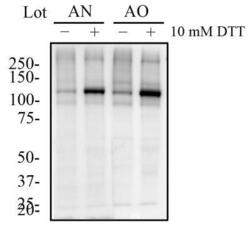
- Experimental details
- Western blot analysis of Phospho-IRE1 alpha (Ser724) in HeLa cells. Samples were incubated in Phospho-IRE1 alpha (Ser724) polyclonal antibody (Product # PA1-16927) using a dilution of 2.0 µg/mL followed by an anti-rabbit HRP secondary antibody. Treated (+) or untreated (-) with 10 mM DTT for 60 min to activate the UPR. Total protein was separated on a 7.5% gel by SDS-PAGE, transferred to PVDF membrane and blocked in 5% BSA in TBST. Detection: chemiluminescence. Theoretical molecular weight: 110 kDa.
- Submitted by
- Invitrogen Antibodies (provider)
- Main image
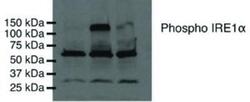
- Experimental details
- Western blot analysis of Phospho-IRE1 alpha (Ser724) in COS-7 untransfected, COS-7 expressing wild-type IRE1 alpha, COS-7 expressing kinase-dead IRE1 alpha. Samples were incubated in Phospho-IRE1 alpha (Ser724) polyclonal antibody (Product # PA1-16927). Lane 1: COS-7 untransfected Lane 2: COS-7 expressing wild-type IRE1 alpha Lane 3: COS-7 expressing kinase-dead IRE1 alpha. Theoretical molecular weight: 110 kDa.
- Submitted by
- Invitrogen Antibodies (provider)
- Main image
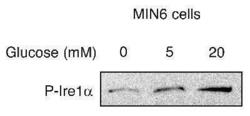
- Experimental details
- Western blot analysis of Phospho-IRE1 alpha (Ser724) in Min6 cells. Samples were incubated in Phospho-IRE1 alpha (Ser724) polyclonal antibody (Product # PA1-16927). Treated with different concentrations of glucose for 3 hours prior to lysates preparation.
Supportive validation
- Submitted by
- Invitrogen Antibodies (provider)
- Main image
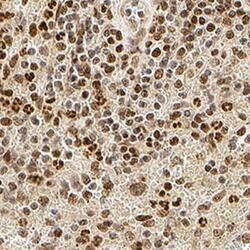
- Experimental details
- Immunohistochemical analysis of Phospho-IRE1 alpha (Ser724) in immersion fixed paraffin-embedded sections of human spleen. Samples were incubated in Phospho-IRE1 alpha (Ser724) polyclonal antibody (Product # PA1-16927) using a dilution of 1:300 for 1 hour at room temperature followed by the Anti-Rabbit IgG VisUCyte™ HRP Polymer Antibody. Tissue was stained using DAB (brown) and counterstained with hematoxylin (blue). Specific staining was localized to the perinuclear cytoplasm in splenocytes.
Supportive validation
- Submitted by
- Invitrogen Antibodies (provider)
- Main image
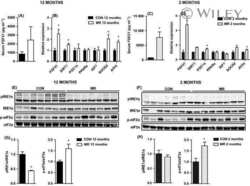
- Experimental details
- NULL
- Submitted by
- Invitrogen Antibodies (provider)
- Main image
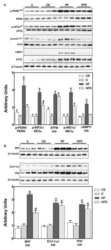
- Experimental details
- NULL
- Submitted by
- Invitrogen Antibodies (provider)
- Main image
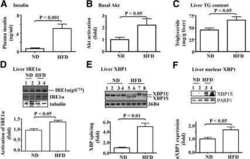
- Experimental details
- NULL
- Submitted by
- Invitrogen Antibodies (provider)
- Main image
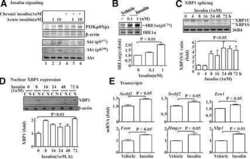
- Experimental details
- NULL
- Submitted by
- Invitrogen Antibodies (provider)
- Main image
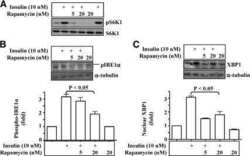
- Experimental details
- NULL
- Submitted by
- Invitrogen Antibodies (provider)
- Main image
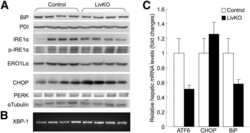
- Experimental details
- NULL
- Submitted by
- Invitrogen Antibodies (provider)
- Main image
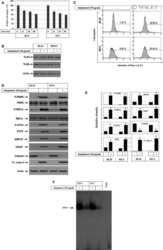
- Experimental details
- NULL
- Submitted by
- Invitrogen Antibodies (provider)
- Main image
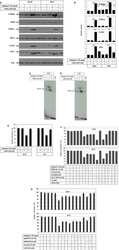
- Experimental details
- NULL
- Submitted by
- Invitrogen Antibodies (provider)
- Main image
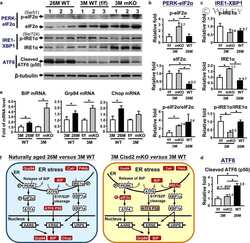
- Experimental details
- NULL
- Submitted by
- Invitrogen Antibodies (provider)
- Main image
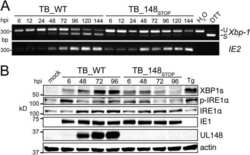
- Experimental details
- NULL
- Submitted by
- Invitrogen Antibodies (provider)
- Main image
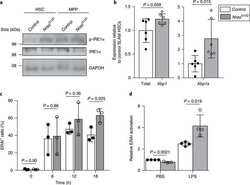
- Experimental details
- NULL
- Submitted by
- Invitrogen Antibodies (provider)
- Main image
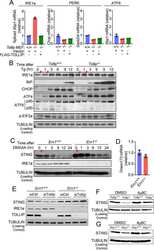
- Experimental details
- NULL
- Submitted by
- Invitrogen Antibodies (provider)
- Main image
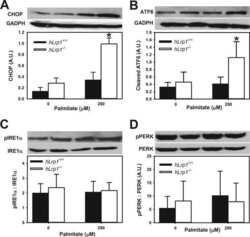
- Experimental details
- NULL
- Submitted by
- Invitrogen Antibodies (provider)
- Main image
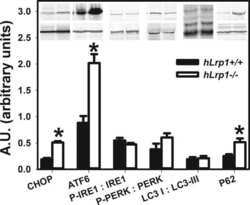
- Experimental details
- NULL
- Submitted by
- Invitrogen Antibodies (provider)
- Main image
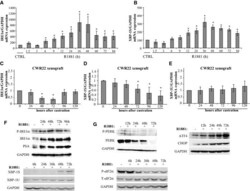
- Experimental details
- Figure 2 Androgens divergently regulate the UPR arms LNCaP cells were cultured and treated with R1881 for the indicated times. A, B mRNA expression levels in LNCaP cells for the indicated genes were investigated using quantitative PCR (qPCR). Controls were treated with vehicle for 84 h and set to 100. Data represent the mean of three independent experiments in triplicate, and bars represent SE. P -values ranged between 1.66 x 10 -5 and 0.025, and IRE1alpha expression in R1881 48 h was * P = 0.013 with respect to vehicle-treated cells using unpaired Student's t -test. C-E IRE1alpha , XBP-1S , and XBP-1U mRNA in CWR22 xenografts grown in nude mice and collected at the indicated times after castration. The value at t = 0 was set to 1. Columns represent the mean of at least three independent tumors for each time point, and bars represent SE. P -values ranged between 5.7 x 10 -10 and 0.0002. IRE1alpha expression at 48 h post-castration was 3.17 x 10 -6 with respect to t = 0 using unpaired Student's t -test. F, G Protein expression in LNCaP cells upon treatment with R1881 for the indicated times by Western blot analysis. Data presented are representative of three independent experiments. Source data are available online for this figure.
- Submitted by
- Invitrogen Antibodies (provider)
- Main image
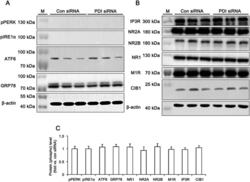
- Experimental details
- Figure 7 Effects of PDI knockdown on ER stress induction and excitatory receptor expressions. ( A ) Western blot data for ER stress makers including pPERK, pIRE1alpha, IRE1alpha and ATF6 at 7 days after PDI siRNA infusion. M, molecular weight marker. ( B ) Western blot data for excitatory receptors including IP3R, NR2A, NR2B, NR1, M1R and CIB1 at 7 days after PDI siRNA infusion. M, molecular weight marker. ( C ) Quantification of effects of PDI siRNA on levels of ER stress markers and receptor expressions (n = 7, respectively). PDI knockdown does not induce ER stress and alterations in excitatory receptor expressions.
- Submitted by
- Invitrogen Antibodies (provider)
- Main image
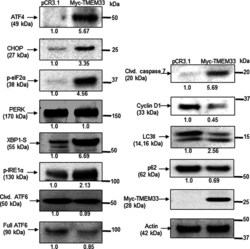
- Experimental details
- Fig. 7 Exogenous expression of TMEM33 in MCF-7 breast cancer cells is associated with constitutive activation of the PERK and IRE1alpha axes of the UPR signaling. MCF-7 cells were transiently transfected with Myc - TMEM33 or pCR3.1 control vector. Adherent and floating cells were collected 24 h post-transfection. Cells were lysed in RIPA lysis buffer supplemented with protease inhibitor (Roche), 10 mM glycerophosphate, 1 mM sodium orthovanadate, 5 mM pyrophosphate, and 1 mM PMSF. Cell lysates (10 mug protein) were immunoblotted with indicated antibodies (all 1:1000 dilution)
- Submitted by
- Invitrogen Antibodies (provider)
- Main image
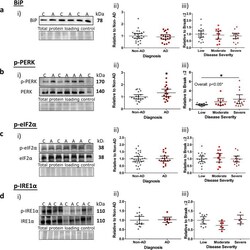
- Experimental details
- Fig. 2 Selective elevation of UPR markers with end-stage AD pathology. i) Representative images of western blots probed for a BiP, b p-PERK/PERK, c p-eIF2alpha/eIF2alpha and d p-IRE1alpha/IRE1alpha. Molecular weights and diagnosis of non-AD (C) and AD (A) are indicated, alongside images of Coomassie total protein stain as loading controls. Markers were quantified according to ii) diagnosis and iii) disease severity (low, 0-2; moderate, Braak 3-4; severe, Braak 5-6). Significant post hoc inter-group differences are indicated (*). For all phosphorylated markers, scatter plots are shown as phospho-signal adjusted for total relative to appropriate controls. BiP ( n = 45), p-PERK ( n = 37), p-eIF2alpha ( n = 45), p-IRE1alpha ( n = 23) data displayed as scatter plots with means with 95% confidence intervals, * p < 0.05
- Submitted by
- Invitrogen Antibodies (provider)
- Main image
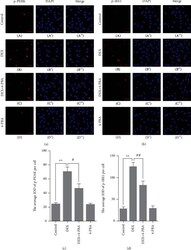
- Experimental details
- Figure 4 (a, b) Representative images showing p-PERK and p-IRE1 immunofluorescence in PC12 cells. (c, d) The average IOD of p-PERK and p-IRE1 per cell. Bars = 25 mu m (magnification: x800). The data are shown as the mean +- SEM, ** P < 0.01 compared with the control group; # P < 0.01, ## P < 0.01 compared with the DEX group. PERK: PKR-like endoplasmic reticulum kinase; IRE1: inositol requirement 1; DEX: dexamethasone; 4-PBA: 4-phenylbutyric acid.
- Submitted by
- Invitrogen Antibodies (provider)
- Main image
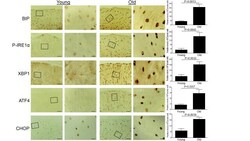
- Experimental details
- Figure 1. Aging induces ER stress in monkey knee cartilages. Articular cartilage sections of young (6-11 yrs, n=3) or old (20-34 yrs, n=3) monkeys were analyzed immunohistochemically for ER stress markers including BIP, P-IRE1alpha, XBP1, ATF4, and CHOP. Images on left panels are low magnification (Scale bars: 100 um). The areas inside the small rectangles were magnified and displayed in right panels (Scale bars: 20 um).
- Submitted by
- Invitrogen Antibodies (provider)
- Main image
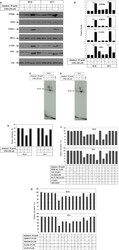
- Experimental details
- Figure 7 ( A ) Western blot analysis demonstrates the inhibition of imiquimod-induced phosphorylation of PERK and IRE 1alpha, the expression and phosphorylation of ATF -4 in melanoma cell lines in response to the treatment with 4- PBA , the inhibitor of ER stress. ( B ) Analyses of band intensity on films are presented as the relative ratio of phospho- PERK , phospho- IRE 1alpha, phospho- ATF 4 and ATF 4 to actin. Bars represent mean +- SD from three blots. * P < 0.05 versus control. # P < 0.05 versus 4- PBA , ++ P < 0.05 versus 4- PBA +imiquimod. EMSA demonstrates the inhibition of imiquimod-induced NF -kappaB activation in BLM ( C ) and MV 3 ( D ) cell lines in response to the treatment with 4- PBA . ( E ) MTT assay demonstrates the abrogation of imiquimod-induced death of both BLM and MV 3 cells in response to the treatment with 4- PBA , the inhibitor of ER stress. ( F ) MTT assay demonstrates the inhibition of imiquimod-induced cell death, in part, by the pre-treatment of melanoma cell lines BLM and MV 3 with the inhibitors of PERK ( GSK 2606414), calpain ( ALLM ), ROS ( NAC ) and completely by the combination of the inhibitors of PERK , ROS with the inhibitor of calpain, whereas, the pre-treatment of melanoma cells with inhibitor of NF -kappaB pathway (Bay11-7082) or the knockdown of XIAP by its specific si RNA enhance imiquimod-induced apoptosis. ( G ) MTT assay demonstrated the inhibition of imiquimod-induced cell death, in part, by the pre- treatment of melanoma cell
- Submitted by
- Invitrogen Antibodies (provider)
- Main image
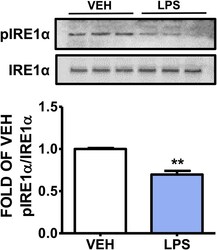
- Experimental details
- Fig. 1 LPS suppresses phospho-IRE1alpha in mice lungs. Western Blot analysis of phosphorylated IRE1alpha (pIRE1alpha) and IRE1alpha in mice lungs treated with either vehicle (saline) or LPS (1.6 mg/kg) via an intratracheal injection for 24 h. The signal intensity of pIRE1alpha and IRE1alpha was analyzed by densitometry. Protein levels were normalized to IRE1alpha. Image J software (NIH) was used to perform densitometry of immunoblots. Graphpad Prism (version 5.01) was used to analyze the data. Student's t-test was performed to determine the statistical differences among groups. **P < 0.01 vs vehicle (VEH), number of animals in each group = 3. Means +- SEM. Fig. 1
- Submitted by
- Invitrogen Antibodies (provider)
- Main image
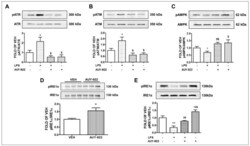
- Experimental details
- Figure 3 Effects of hsp90 inhibition in major inflammatory cascades of the murine inflamed lungs. Western blot analysis of phosphorylated ATR (pATR) and ATR ( A ), phosphorylated ATM (pATM) and ATM ( B ), phosphorylated AMPK (pAMPK) and AMPK ( C ), phosphorylated IRE1alpha (pIRE1alpha) and IRE1alpha ( E ) expression in lungs retrieved from mice 72 h after intratracheal injection of either vehicle (saline) or LPS (1.6 mg/kg) and post-treated (24 h after LPS) with an intraperitoneal injection of either AUY-922 (10 mg/kg each, dissolved in 10% DMSO) or vehicle (10% DMSO in saline). The signal intensity of protein bands was analyzed by densitometry. Protein levels of pATR, pATM, pAMPK and pIRE1alpha were normalized to ATR, ATM, AMPK and IRE1alpha, respectively. * p < 0.05, ** p < 0.01 vs. vehicle (VEH) and $ p < 0.05, $$ p < 0.01 vs. LPS, n = 3 animals per group. Means +- SEM. Western Blot analysis of phosphorylated IRE1alpha (pIRE1alpha) and IRE1alpha ( D ) in mouse lungs treated with either vehicle (10% DMSO in saline) or AUY-922 (10 mg/kg each, dissolved in 10% DMSO) via an intraperitoneal injection for 48 h. The signal intensity of pIRE1alpha and IRE1alpha was analyzed by densitometry. Protein levels of pIRE1alpha were normalized to IRE1alpha. * p < 0.05 vs. vehicle (VEH), number of animals in each group = 3. Means +- SEM.--indicates the absence, and + indicates the presence of the corresponding reagent in the treatments.
- Submitted by
- Invitrogen Antibodies (provider)
- Main image
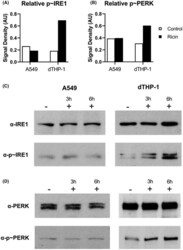
- Experimental details
- FIGURE 3 Evidence for ER stress in dTHP-1 but not A549 cells. The relative abundance of phosphorylated IRE1 (A, C) and phosphorylated PERK (B, D) in response to 6 h ricin treatment (black bars; 20 ng/ml) or controls (white bars) in dTHP-1 cells. Bars represent the semi-quantitative signal density of the phosphorylated form of each protein relative to the total pool of that protein probed sequentially on the same membrane swatch. Digitized films of representative western blots selected from among three to four replicate experiments. Membrane swatches were probed with anti-phospho-PERK (Cell Signaling Technology Cat# 3179, RRID:AB_2095853) or anti-IRE1 (Cell Signaling Technology Cat# 3294, RRID:AB_823545), then stripped and re-probed with anti-PERK (Cell Signaling Technology Cat# 3192, RRID:AB_2095847) or anti-phospho-IRE (Thermo Fisher Scientific Cat# PA1-16927, RRID:AB_2262241) antibodies. Results at 3 h treatments were variable and thus were not included in the semi-quantitative graphs in (A) and (B). Refer to Figures S3-S6 to observe the original films from which these images were derived
- Submitted by
- Invitrogen Antibodies (provider)
- Main image
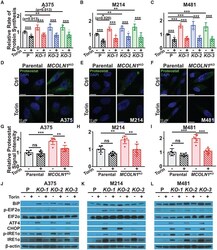
- Experimental details
- Figure 6. MCOLN1/TRPML1 Deficiency Increased Protein Synthesis and Proteotoxic Stress as a Result of mTORC1 Activation (A-C) Relative rate of incorporation of a pulse of OP-Puro in cultured parental cells (P; black) versus MCOLN1 -deficient clones (red, blue, and green) from A375 (A), M214 (B), and M481 (C) treated with DMSO control (solid bars) or 5 nM Torin1 (striped bars). Data represent mean +- SD from two independent experiments with 3 replicate cultures per treatment per clone per experiment. (D-I) Intracellular protein aggregates were visualized by staining with Proteostat dye (D-F) and then quantified (G-I) in parental cells (black) versus MCOLN1 -deficient clones (red) treated with DMSO control (solid bars) or 5 nM Torin1 (striped bars). Data represent mean +- SD from two independent experiments with 3 replicate cultures per treatment per clone per experiment. (J-L) Western blot analysis of BiP, p-eIF2 alpha (S51), total eIF2 alpha , ATF4, CHOP, p-IRE1 alpha (S724), total IRE1 alpha , and beta-actin in cultured parental cells or MCOLN1 -deficient cells from A375 (J), M214 (K), and M481 (L) treated with DMSO (-) or 5 nM Torin1 (+). The blot reflects one representative experiment (of two performed) per melanoma. Statistical significance was assessed using two-way ANOVAs followed by Sidak's and Dunnett's multiple comparisons tests (A-C) or two-way ANOVAs followed by Sidak's multiple comparisons tests (G-I); ns, not significant; *p < 0.05; **p < 0.01; ***p < 0.001. Scale
- Submitted by
- Invitrogen Antibodies (provider)
- Main image
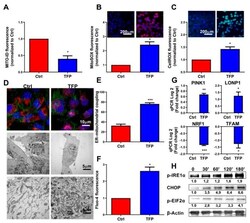
- Experimental details
- Figure 3 Trifluoperazine promotes mitochondrial and ER coupled stress. ( A ) Flow cytometry analysis of MiaPaCa-2 cells treated with 10 muM TFP for 24 h was done with MITO-ID for analyzing mitochondrial membrane potential. ROS production was detected using MitoSOX Red ( B ) and CellRox Green ( C ) by flow cytometry analysis in TFP and non-treated cells. ( D ) Representative transmission electron microscopy pictures with different magnifications of the MiaPaCa-2 cells after treatment with 10 muM TFP for 24 h are shown. ( E ) Percentage of mitochondria with ER contacts per field (mean of 10 fields) on each condition; not less than 250 mitochondria were counted. ( F ) Flow cytometry analysis with Fluo-4-AM was performed to determine cytosolic calcium concentration. ( G ) Total RNAs were extracted to monitor the mRNA level of genes involved in the mitochondrial dynamic. ( H ) Western blot analysis was performed to evaluated protein levels of expression of Phospho-IRE1alpha, Phospho-eIF2alpha, CHOP, and beta-actin in TFP-treated cells. For each treatment, statistical significance is * p < 0.05, ** p < 0.01, *** p < 0.001, and **** p < 0.001 compared with untreated cells (Student's 2-tailed unpaired t -Test). Data represent mean +- SEM, n = 3 (with technical triplicates).
- Submitted by
- Invitrogen Antibodies (provider)
- Main image

- Experimental details
- Figure 3 Hepatic cellular stress response after thermal injury. (A) Representative images of Western blot of multiple cellular stress markers in whole liver lysate in different time after burn injury as compared with sham. (B) to (G) Densitometric analysis of the Western blots of phospho-IRE1alpha (B), CHOP (C), phospho-eIF2alpha/eIF2alpha (D), ATF4 (E), BiP (F) and HSP90 (G). Data are presented as means +- SEM. * P < .05 as compared with all the other groups. # P < .05 as compared with Sham. $ P < .05 as compared with PBD42. p p < 0.05 as compared with PBD21, 28 and 42. N = 6 animals per group including non-tamoxifen control, sham and different time-point post-burn
- Submitted by
- Invitrogen Antibodies (provider)
- Main image
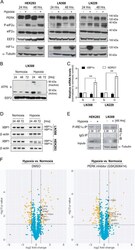
- Experimental details
- Fig. 1 PERK-mediated secretion of proteins under hypoxia. a Total PERK, eIF2alpha and P-eIF2alpha expression in HEK293, LN308 and LN229 cell lines under normoxia or hypoxia. b Active form of ATF6alpha (50 kDa band) in LN308, under hypoxia for 24, 48 and 72 h. EEF2 was used as a loading control. c Relative mRNA levels of XBP1s as determined by qRT-PCR in LN308 and LN229 cell lines under hypoxia (48 h). NDRG1 was taken as a positive control for hypoxia induction. EEF2 was used as housekeeping gene. Data are normalized to the respective normoxic conditions and are represented as the mean of three independent experiments +- SEM ( T test: ** p value < 0.01). N normoxia, H hypoxia. d Total XBP1s mRNA transcripts in HEK293 and LN308 cells treated with hypoxia for 24, 48, 72 h. beta-actin was used as a housekeeping gene. e Total P-IRE1alpha species immunoprecipitated using P-IRE1alpha antibody from HEK293 and LN308 cells treated with hypoxia for 48 h. f Volcano plot representing the regulated secretory proteins from LN308 glioblastoma cells under hypoxic conditions for 72 h without (left) and with PERK inhibitor (GSK2606414; right). The data are represented as the mean of three independent replicates. The significant p value cut-off was set at 0.05.
 Explore
Explore Validate
Validate Learn
Learn